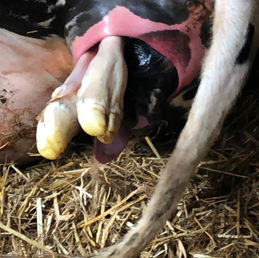Author: A. L. Lindau
On a farm with an average livestock of 25 Simmental-Cows, the problem of oversized calves occurred in approximately one quarter of all calving. In summer Cows and heifers are grazing, in winter the cows are tethered inside the stable and fed with hay and grass silage. Calving season is in winter. To prevent calf-deaths, death of cows and birth injuries in cows due to oversized calves we developed a system to evaluate the size of the unborn calf and the probability of natural birth.

As soon as the amniotic sack is broken, an obstetric examination is conducted. The calf is pulled carefully towards the cervix. When the forehead of the calf is due to enter the pelvic passage of the birth paths one flat hand of the examiner is placed onto the forehead of the calf. With the hand resting on the forehead the calf is carefully pulled further into the birth path. If the hand of the examiner is lightly squeezed but can be held resting on the calves forehead without great effort the calf can be born in the natural way. If the hand of the examiner is squeezed so severely it is hardly to bear or even impossible the veterinarian is informed immediately.
The decision if the calf can be born naturally is delegated completely to the veterinarian. With implementing this good practice, it was possible to reduce mortality of calves during birth significantly. If at all, birth injuries in cows are occurring only in single cases.
In the presented case, farmer and veterinarian carried out the evaluation of calf’s size together during the next calving. No written instruction was developed but the procedure is a verbal agreement, which has been practiced under supervision first. The farmer had to learn the limit to which size the calves were able to pass through birth paths without being harmed and causing any harm. The development of good judgement skills for this lasted about one calving season.
In practice it is necessary to remember:
- there is only "too big" or "able to pass" NO "let's try”!
- if unsure leave the decision to the veterinarian
- the good practice has to be carried out in every calving, also at night!
This Good Practice has an Impact on:
- Socio-economic resilience: decreased veterinary costs, less losses of calves and cows to dystocia
- Animal health and welfare: decreased veterinary costs, reduction of deaths of calves during calving, reduction of birth injuries in cows, increased longevity of cows
- Production efficiency and meat quality: Increase of number of calves to be raised, decrease of number of productive cows with early culling because of injuries
Hier klicken, um diesen Artikel auf dem BovINE-Knowledge-Hub auf Deutsch zu lesen.